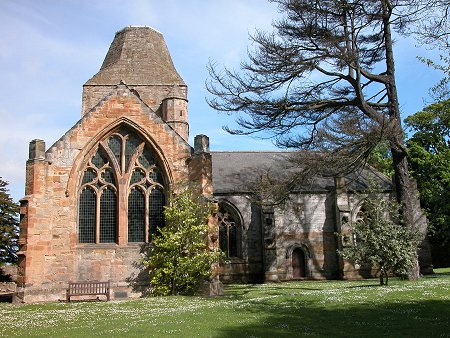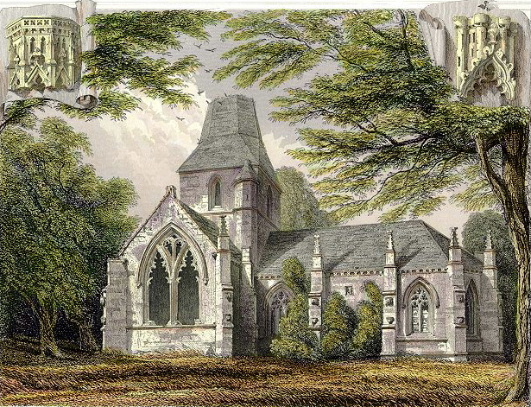
|
A Brief History of Seton Collegiate Church
The origins of Seton
Collegiate Church go back to 1242 when the
Seton Church was dedicated in
the names of St. Mary and the Holy Cross, and
was
consecrated by the Bishop of
St Andrews. The Church stands on a
site previously occupied by the thirteenth century parish church,
two miles east-north-east of Prestonpans.
The original church
was a rectangular building which later became the nave of the
Collegiate Church, and whose foundations can be seen to the west
of the surviving building.
Dated before 1390, when a south aisle was built by
Catherine Sinclair, widow of William, the First Lord Seton.
In 1434 a side
chapel was added by Lady Janet Dunbar to house the tomb of her
late husband, Sir John Seton, the 2nd Lord Seton, and part of this
side chapel was replaced by the later south transept, where other
parts can be traced on the ground to the west of the south
transept. Unfortunately, the side chapel no longer exists
although fragments can still be identified. The Grandson of John
and Katherine, George, 3rd Lord Seton, founded a college of
priests to pray for his soul and those of ancestors and family.
George began the building of the 'Magnificent Choir' - an addition
to the east of the existing structure. To the north of the choir
he built a sacristy - used by priests to make the necessary
arrangements for masses etc. He died in 1478 '... in the place
of the Blak freires of Edinburgh queir he lyis in the queir of the
samin.' Pope Paul II had granted a mandate c.1471 for
the church to be erected into a collegiate church but this does
not appear to have been acted upon.
Collegiate Churches were established for a number of reasons, for instance: - As centres of learning (especially law) - As places for the study of Theology - As establishments given over to prayers for the souls of members of a particular family in perpetuity, or of his predecessors, and descendants.
The fourth Lord
Seton was educated in Paris and St Andrews. He obtained official
sanction to erect the church into a collegiate church from Pope
Alexander VI, completed the choir in the 1480s, and received
permission from the Pope to set up a college of priests in 1492.
The
Church was erected as a Collegiate Church on 20 June 1493 and
the church
was dedicated to St Mary and the Holy Cross. The college comprised
of a Provost, six Priests, a Clerk together with two choir boys.
George was described as a man '... of cunning in astrology,
theology and music.' He completed the work begun by his father
by vaulting the choir and sacristy.
Church
income was thereafter entirely devoted to the upkeep of the
Provost and canons, who were responsible for the cure of souls.
He built much
of the choir which now forms the east end of the church and the
sacristy, the side room to its north, and other additions to the building were made by George,
4th Lord
Seton who died in 1508, and his son, George, 5th Lord Seton who perished at Flodden
together with
much of the Scottish aristocracy of the day at the Battle of
Flodden
in 1513. Thereafter, another Lady Janet Seton, nee Hepburn,
added the
north transept in 1541 and
generously
endowed the Church and
who oversaw the
repairs, which involved the demolition of the 1434 side chapel and
its partial replacement with the south transept. She also built
the tower, the spire of which was never completed beyond the
attractive stump you see today. Lady Janet Seton died in
1558, 45 years after her husband's death at Flodden, at a
considerable age.
In 1544
however, the Church had been damaged by the English
during the invasion of the Earl of Hertford, who looted and
stripped the vestments, communion vessels, organ and bell before
burning the timber work in the building.
In 1560, the
Reformation swept across Scotland and the religious community here
was dissolved. For a while the church returned to its first use in
service of the community, but in
1580,
the parish of Seton was joined with that of Tranent and the need
of a separate church disappeared.
Still, it was well patronised by the Seton family and
reverted to a
private chapel for family use.
In the years
that followed, the church it was further damaged by zealots during
the Wars of the Covenant in the mid 1600s. About 1688 a mob
damaged the church by smashing the windows, defacing memorials and
gravestones, and many items not of religious nature but which were
valuable were stolen.
The Seton family
were staunt supporters of the Royal Stuart family, and their
support for the 'Old Pretender', James Stuart (1688-1766) led to
the church being desecrated in 1715 by the Lothian Militia
who
desecrated the
church,
incited by the fact that Lord
Winton was a Jacobite, and defaced the interior and
demolished tombs and pavements looking for treasure and the lead
used to encase bodies, and demolished the entrance and original
nave.
In view of their long connection with the
Church, there are many monuments to the several members of the
Seton family, which were preserved by the
Earls of Wemyss
who acquired and
restored the property
and
the surviving parts to become a family burial vault. The
Wemyss family passed it into state care in 1946, and granted the
church and immediate surroundings to the people of Scotland and is
now in the care of Historic Scotland, the Government body in
Scotland, which preserves such edifices for the Scottish nation.
The Murdered Apprentice One of the most interesting aspects of the lore of Seton Collegiate Church is that it like, Rosslyn Collegiate Church, also has a legend of a murdered apprentice. The legend is virtually the same as that at Rosslyn except that it doe not involve a pillar. The story is that the Master Mason in charge of building the church had a major problem erecting the vaulted roof of the nave and went to another church to examine how the vaulted roof there had been erected. It is not known if the church he visited was local or, as in the case of the Rosslyn legend, was somewhere overseas. Given that there were a number of churches in the vicinity with vaulted roofs it seems likely that a long journey was not involved. In the absence of the Master Mason an apprentice had made the mathematical calculations and drawings showing how the vaulted roof could be built. The Master Mason, his pride being badly bruised (not to mention his ruined reputation of 'Master'), flew into a rage and hit the apprentice with a mallet killing him on the spot. Unlike Rosslyn there is no evidence that the remaining masons thought it worthwhile commemorating the Master Mason or the Apprentice's mother with a stone carving but there is a carving of the murdered apprentice. It is believed that the Seton Master Mason was none other than the Master Mason from Rosslyn Collegiate Church who had not in fact committed suicide after killing the Apprentice there but had moved to Seton in order to design and later build that church the re-construction of which began in 1470. However, the legend of a murdered apprentice is more common than one might think, there are a number of buildings in the UK and in other countries with the same or similar legends. Seton Collegiate Church is an impressive building with a friendly atmosphere. The transepts, choir and sacristy are in good condition and full of fascinating detail, from the possible tomb of the 4th Lord Seton and the original cracked dutch bell which hung in the tower from 1577, and is now on show in the crossing. In the grounds are the remains of the priests' houses, and there is a display of stonework recovered from Seton Palace, destroyed in 1715 and which was later replaced by Seton House Castle to the west of the church.
 |

